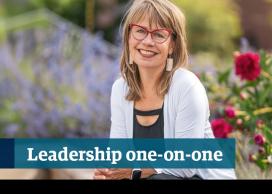Dr. Simon Bates is UBC’s Associate Provost, Teaching and Learning. He provides academic leadership and oversight of the Centre for Teaching, Learning and Technology (CTLT), UBC Extended Learning, and the UBC Learning Exchange, and also oversees the development of new programs and curriculum quality assurance. A passionate advocate and champion of technology-led learning, Simon joined UBC in 2012 as the Academic Director of CTLT and as one of the first Professors of Teaching at the university in the Department of Physics and Astronomy.
Q1. What quality do you admire most in a leader?
SB: The ability to say ‘I don’t know’ and to reach out for support and advice is definitely something I admire. So, a sense of humility, if you like, and also not taking yourself too seriously. As someone once said, “No matter who you are, you still put your pants on one leg at a time”.
Q2. What makes you laugh?
SB: Happily, lots of things. I find a lot of situations to be amusing, sometimes to the point of irreverence. In terms of a style of humour, what consistently makes me laugh is physical humour and slapstick. My sense of humour was heavily influenced by growing up in the UK watching TV shows including Monty Python, The Young Ones, Blackadder and Fawlty Towers.
Q3. Who inspires you, and why?
SB: The physicist, Richard Feynman. He was one of the most brilliant minds of his generation and won a Nobel Prize for his work. Aside from making a profound contribution to the discipline and his brilliance as a researcher, he had an absolutely unique way of understanding the world and a passion for wanting to communicate it to other people in a way they could understand. If you asked any faculty member in any physics department what books they bought as a graduate student, I’m sure they would say the three volumes of The Feynman Lectures on Physics. They are still the best textbooks you could ever find.
Q4. For you, what makes UBC different?
SB: Two things stand out to me. One is the physical place — I think UBC is one of the most spectacular campuses I have ever been to. But more than its physical beauty, it’s the history of our campus and the fact it is located on traditional ancestral land of the Musqueam people who have used this as a site of learning for thousands of years, that makes it so unique.
The other difference is UBC is an institution that genuinely thinks it can, and should, be a world leading research university, while at the same time also being known internationally for the quality of, and innovation in its teaching. As someone who has worked at a number of research-intensive universities, this aspiration for real parity between the two functions at UBC is really refreshing.
Q5. What is the most important lesson you’ve learned in your career to date?
SB: Do not underestimate how hard it is to implement change. The process of influencing a change in academic culture is something that happens very slowly. It doesn’t happen without care and attention being devoted to it, particularly when it comes to the people involved. One of the biggest change projects I’ve worked on recently is the migration to the new learning management system, Canvas. It was a high-stakes transition, but it taught me a lot about the value in involving people affected by the change — in this case faculty and students — from the outset.
Q6. How do you like to recharge?
SB: In three words — wheels, boots and hooves.
I try to cycle to and from work which gives me thinking time and exercise in an otherwise fairly sedentary workday. I might be freezing cold or soaking wet, but I’m never unhappy on two wheels. The ‘boots’ refer to hiking — I love going on long hikes with my son. And the ‘hooves’ represent the big part horses play in my life. My wife trains them so I spend a lot of my weekends helping out on the farm, which is a wonderful contrast to what I do during the week.
Q7. What is the best advice you were ever given?
SB: As you move into more administrative and leadership roles as an academic, it can be very easy to give up some of the things that matter to you. I’ve seen so many people in similar roles to me give up teaching and they very quickly lose touch. So the best advice I’ve been given is that teaching has a very short half-life — don’t give it up because you’ll find it hard to start again.
Q8. What do you value in your colleagues?
SB: Enthusiasm, energy, and a commitment to a greater cause. So, seeing things from a wider perspective than just your course, your department or even your faculty, and being willing to compromise.
Q9. What would you like to be remembered for?
SB: Making a difference to the lives of some of the students I’ve been fortunate enough to teach, as well as to the broader educational landscape. I was part of the very first cohort of Professors of Teaching at UBC, and being an advocate for the value of that rank and career track is also something I’d like to be associated with.
Q10. If you could have a super power, what would it be?
SB: The ability to be in multiple places at once — there’s far too much to do and not enough time. But I should be clear that I’m not referring to cloning, as that would mean there would be multiple of me running around which is a very frightening prospect!
Q11. How is technology changing the way students learn at UBC to help them reach their potential?
SB: Technology offers amazing potential for connectivity, interactivity and for collaboration on a scale that simply didn’t exist even 15 years ago. The locus of a student’s academic world was once only the classroom and the campus. Today, technology is blurring the physical and temporal boundaries of our university.
Q12. What do you hope to achieve in your role in the coming years?
SB: As an institution, I’d like us to start thinking more deliberately about articulating the skills and competencies that students taking our degrees and programs will get. So not course-level outcomes, but holistic program-level ones. By doing so, we will create a framework for thinking about how the programs and curriculum within a department should evolve.
Something I’d also like to see as student demographics change — as the number of 18-24 year olds coming to university declines and the number of 25-45 year olds increases — is the provision of more flexible educational offerings. As demand for courses and programs that people can do in smaller chunks and in more flexible modalities continues to grow, we need to ensure we’re meeting that.
Published: December 1, 2018
Interviewed by: Celia Britton, UBC Internal Communications



